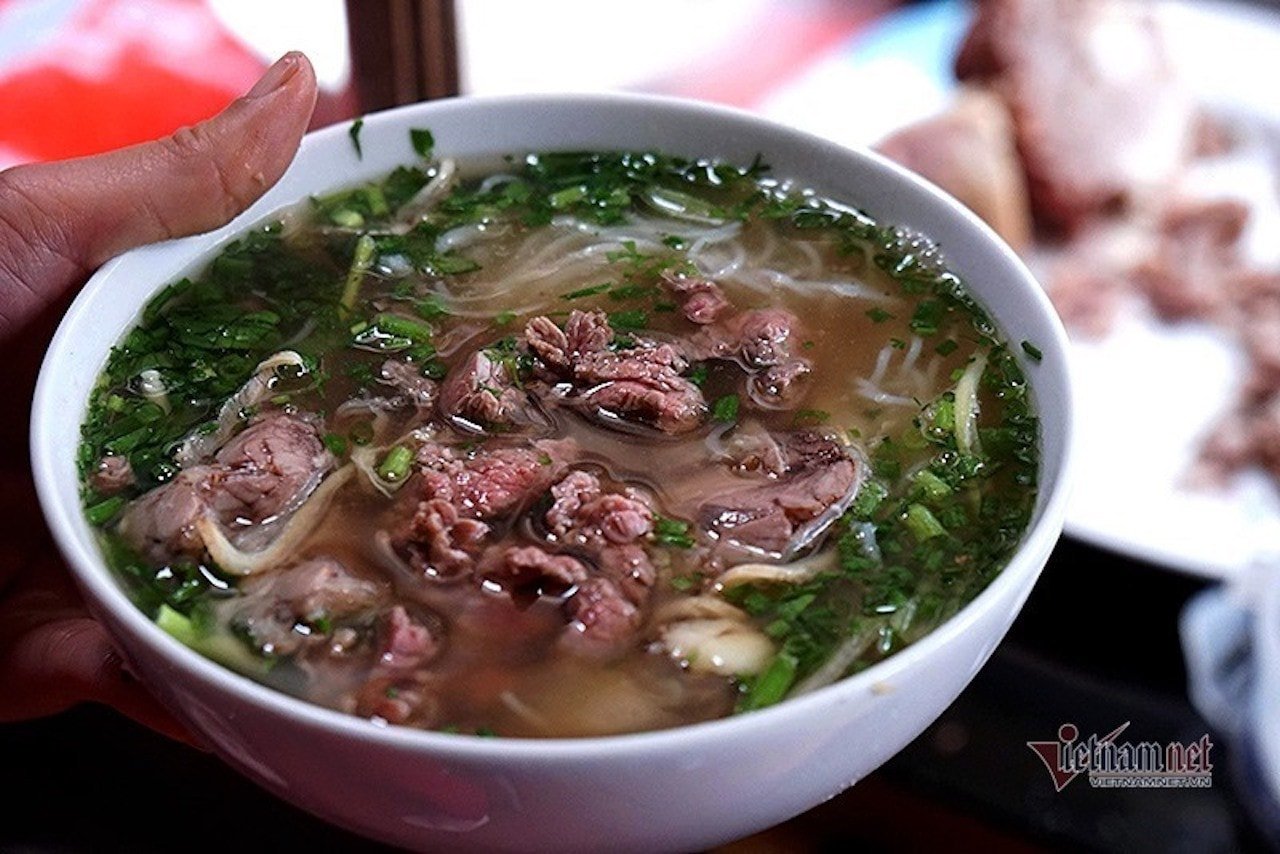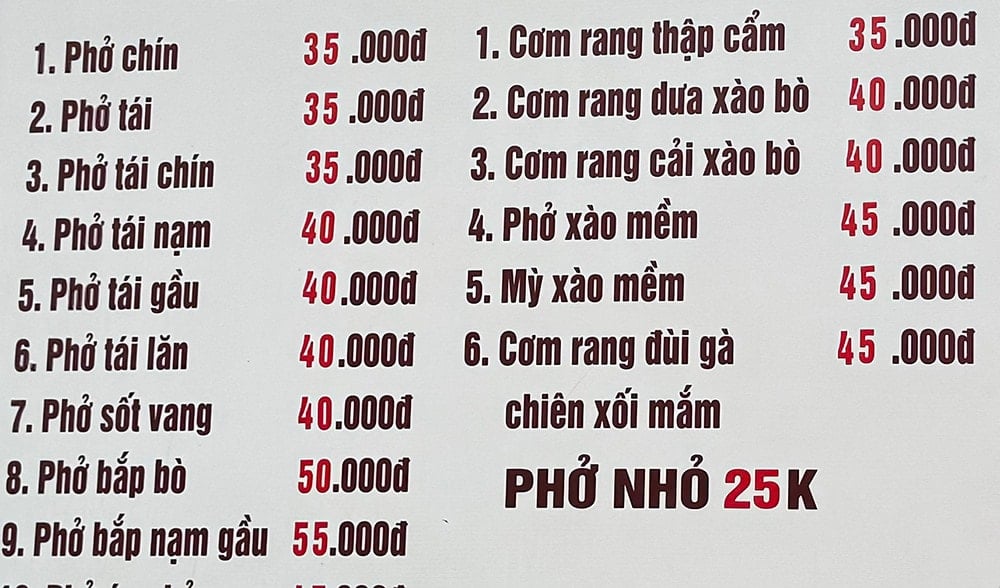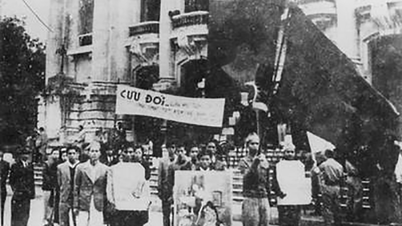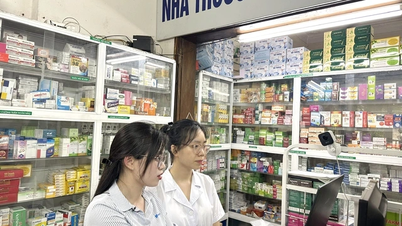
When ordering a bowl of pho at the corner of Linh Dam Street (Hoang Mai District, Hanoi ), Mr. Nguyen Van Tuan was startled to hear the new price of 35,000 VND/bowl. Looking at the new price list of the restaurant, Mr. Tuan realized that each bowl of pho had increased by 5,000 VND compared to before. The lowest price for a bowl of pho is 35,000 VND, the highest is up to 55,000 VND.
Although he sympathized with the restaurant, Mr. Tuan still complained: "Just the breakfast cost each month has increased by several hundred thousand dong, which is also a significant amount."
Explaining the price increase, a restaurant employee said: “Previously, we used to import goods from familiar sources without invoices or documents. But now, when stores have to declare taxes based on revenue, we are forced to source input materials from units with valid documents. This causes costs to increase significantly."
In addition, the restaurant also had to invest in a cash register to issue electronic invoices, connecting directly with the tax authorities. "Many input materials have increased, and in the summer, we have to use air conditioning, so the electricity bill also increases. If we don't adjust the selling price, the pho restaurant will have a hard time surviving in an area with sky-high rental prices like this," said this employee.
A representative of a pho restaurant confirmed that the entire menu has been adjusted, increasing by 5,000 VND/bowl. This new price has been applied since the beginning of the week and most customers have sympathized. The restaurant is also having a headache finding a source of reasonably priced ingredients to keep the selling price reasonable in the coming time.
Similarly, a famous bun rieu shop in Hanoi has just announced a price increase. The shop staff explained: "The shop is now using electronic invoices generated from the cash register that is directly connected to the tax authority. This means that VAT must be added to the selling price for customers, instead of only being calculated when customers request a red invoice as before."
"From onions, tomatoes to crabs, to fish sauce bottles, all have taxes added, so the price of a bowl of noodles increases is inevitable. We hope you understand," said the employee.
The restaurant admits that raising prices will cost customers more and could affect sales, but it is the only solution without reducing the quantity of dishes or finding poor quality ingredients.
Although the price increase is only 5,000 VND/bowl, for many customers, this is creating a big burden.
Ms. Nguyen Thi Quynh (an office worker in Thanh Xuan, Hanoi) said: "Every month, I go out for breakfast a few times, but now each meal costs 5,000-10,000 VND more, the difference is obvious." In the context of no increase in income but increasing living expenses, Ms. Quynh said she will have to reconsider her eating out habits.
Should we rush to increase prices?
Adjusting prices will help restaurant owners maintain profit margins, offset increased costs, and improve service quality and customer experience. However, price increases can lead to reduced consumption if not done carefully and flexibly.

Mr. Nguyen Tuan Linh, owner of a restaurant in Hanoi, said that customers are usually only interested in the price of a bowl of pho or a bowl of vermicelli. If the price is only increased without any change in quality or service, customers will think the price increase is unreasonable. Thus, the restaurant may lose a significant number of customers.
According to Mr. Linh, stores need to carefully study the impact of taxes on selling prices to have appropriate adjustments. They should not rush to increase prices immediately, which will have a negative impact on customers when they understand that they have to pay taxes on behalf of the store owner.
In case of forced price increase, restaurant owners need to clearly notify customers and the specific time of implementation, to avoid making them feel uncomfortable.
“By hastily increasing prices without any innovation, the restaurant owner can turn away customers. Don’t lose a stable source of customers for short-term benefits,” said Mr. Linh.
Sharing the same view, Mr. Nguyen Thai Binh , co-founder of Concepts Academy - VCS, analyzed that increasing product prices should be carefully considered due to high input costs but weak market purchasing power. Sudden price increases can affect sales as customers are increasingly cautious in spending.
Instead of raising prices across the board, businesses should optimize costs by negotiating with suppliers, adjusting processing formulas or product quantities. If it is necessary to increase prices, a flexible strategy should be applied according to regions, customer groups and combined with improving product value to maintain attractiveness.
HA (according to Vietnamnet)Source: https://baohaiduong.vn/bat-bun-pho-dong-loat-tang-5-000-dong-chu-quan-noi-do-hanh-thit-cua-deu-ganh-them-thue-413639.html






































































































Comment (0)